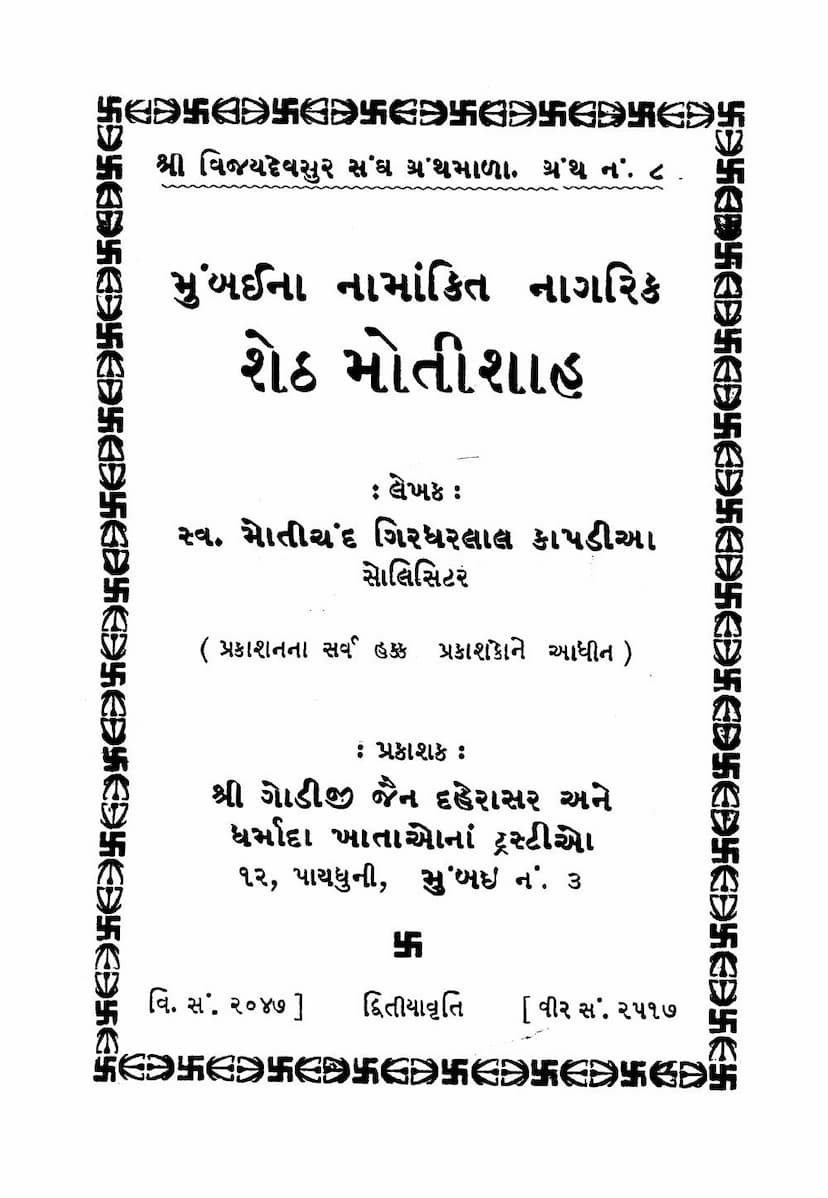Sheth Motishah
Added to library: September 2, 2025

Summary
This Jain text, "Sheth Motishah," authored by Motichand Girdharlal Kapadia and published by Godiji Jain Derasar ane Dharmada Trust, is a comprehensive biography of Sheth Motishah, a prominent Jain philanthropist and businessman from 19th-century Mumbai. The book, published in Gujarati, details Motishah's life, from his humble beginnings to his rise as a successful merchant, his significant contributions to Jain religious and social causes, and the socio-economic context of his time.
Key aspects covered in the book include:
- Early Life and Background: The book begins by setting the scene of 19th-century India, highlighting the political and social conditions. It then traces Motishah's family history, their migration from Khambat to Mumbai, and his early life and education.
- Business Acumen and Success: Motishah's journey in the shipping and trade industry, particularly his ventures into trade with China and other regions, is detailed. His astute business sense, courage, and far-sightedness are emphasized, noting his significant wealth accumulation.
- Religious and Social Contributions: A substantial portion of the book is dedicated to Motishah's immense contributions to Jainism and society.
- Temple Construction: The book extensively describes his role in the construction and renovation of several Jain temples in Mumbai, including the prominent Shri Godiji Parsvanath temple and the Bhavkhala temple. His personal involvement and financial contributions to these projects are highlighted.
- Philanthropy: Motishah's deep commitment to animal welfare is evident in his pioneering role in establishing the Mumbai Panjrapole (animal shelter). The book details the circumstances leading to its establishment and his substantial donations towards its upkeep.
- Community Welfare: His involvement in various community initiatives, including education and social welfare, is also noted.
- Detailed Account of the Palitana Shatrunjay Temple Complex: The book provides a meticulous account of Motishah's vision and execution of building a grand temple complex on Shatrunjay hill in Palitana. This includes the challenges of site selection, the monumental effort of filling the Kuntasar ravine, the meticulous planning and execution of the construction, the sourcing of materials, and the employment of numerous artisans. The detailed description of the architecture, the placement of idols, and the associated rituals are significant.
- The Grand Pratishtha (Consecration) Ceremony: The book describes the elaborate and multi-day consecration ceremony of the temples built by Motishah in Palitana. It details the massive scale of the event, the participation of numerous religious leaders from different sects, the extensive arrangements for pilgrims, and the philanthropic activities during the festival.
- Personal Life and Values: While focusing on his public contributions, the book also touches upon his personal life, his relationship with his family, his steadfast faith, and his ethical conduct in business. His dedication to his father's business even after his father's death and his respect for his family's legacy are evident.
- Trusteeship and Legacy: The book highlights Motishah's responsible stewardship of religious trusts and his commitment to ensuring the long-term welfare of the institutions he supported. His will and the provisions made for the continuation of his charitable activities are also discussed.
- Appendices and Supporting Documents: The book includes appendices that provide further details, such as inscriptions from the temples, relevant historical letters, and financial records related to his donations, offering primary source material to support the narrative.
The author, Motichand Girdharlal Kapadia, a solicitor, undertook extensive research to compile this biography, gathering information from various sources to present a comprehensive picture of Motishah's life and impact. The book serves as a testament to Motishah's remarkable contributions to Jainism and society, portraying him as a visionary, a devoted follower of Jain principles, and a generous philanthropist whose legacy continues to inspire. The text is written in Gujarati, offering a rich historical and cultural insight into the Jain community of that era.